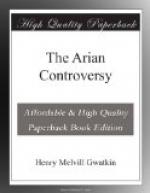the creed the instant they got the upper hand in 381?
And such a revision! The elaborate framework
of Nicaea is completely shattered, and even the keystone
clause ’of the essence of the Father’
is left out. Moreover, (2.) there is no contemporary
evidence that they did revise it. No historian
mentions anything of the sort, and no single document
connected with the council gives the slightest colour
to the story. There is neither trace nor sign
of it for nearly seventy years. The internal evidence
(3.) points the same way. Deliberate revision
implies a deliberate purpose to the alterations made.
Now in this case, though we have serious variations
enough, there is another class of differences so meaningless
that they cannot even be represented in an English
translation. There remains (4.) one more argument.
The spurious Nicene creed cannot be the work of the
fathers of Constantinople in 381, because it is given
in the Ancoratus of Epiphanius, which was certainly
written in 374. But if the council did not draw
up the creed, it is time to ask who did. Everything
seems to show that it is not a revision of the Nicene
creed at all, but of the local creed of Jerusalem,
executed by Bishop Cyril on his return from exile
in 362. This is only a theory, but it has all
the evidence which a theory can have—it
explains the whole matter. In the first place,
the meaningless changes disappear if we compare the
spurious Nicene creed with that of Jerusalem instead
of the genuine Nicene. Every difference can be
accounted for by reference to the known position and
opinions of Cyril. Thus the old Jerusalem creed
says that the Lord ’sat down at the right
hand of the Father;’ our ‘Nicene,’
that he ‘sitteth.’ Now this
is a favourite point of Cyril in his Catecheses—that
the Lord did not sit down once for all, but that he
sitteth so for ever. Similarly other points.
We also know that other local creeds were revised
about the same time and in the same way. In the
next place, the occurrence of a revised Jerusalem
creed in the Ancoratus is natural. Epiphanius
was past middle life when he left Palestine for Cyprus
in 368, and never forgot the friends he left behind
at Lydda. We are also in a position to account
for its ascription to the council of Constantinople.
Cyril’s was a troubled life, and there are many
indications that he was accused of heresy in 381, and
triumphantly acquitted by the council. In such
a case his creed would naturally be examined and approved.
It was a sound confession, and in no way heretical.
From this point its history is clearer. The authority
of Jerusalem combined with its own intrinsic merits
to recommend it, and the incidental approval of the
bishops at Constantinople was gradually developed
into the legend of their authorship.
[Sidenote: The rest of the canons.]




